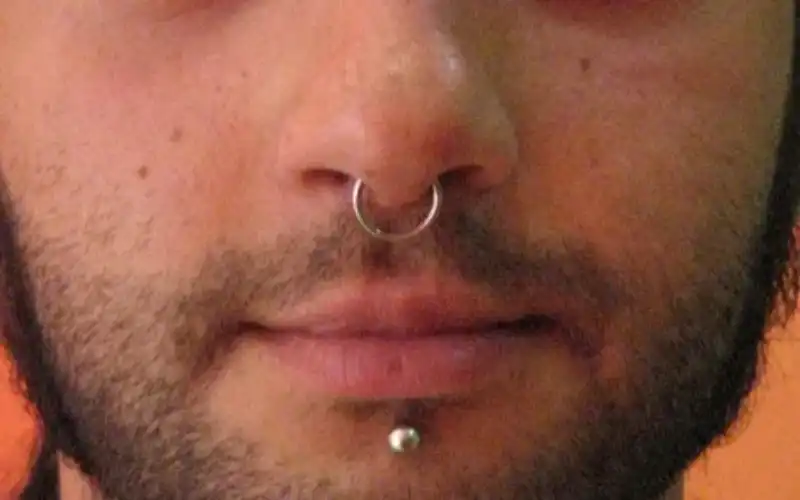Introduction:

Septum piercings have become increasingly popular in recent years as a trendy and versatile form of body modification. This type of piercing involves perforating the thin wall of skin and cartilage that separates the nostrils, known as the septum. If you’re considering getting a septum piercing or are simply curious about this unique form of self-expression, this article will provide you with a comprehensive guide to everything you need to know about septum piercings.
The History of Septum Piercing:
Septum piercing has a rich history that dates back centuries. It has been practiced by various cultures across the world, including the Native American tribes, the Aztecs, and various African and South Asian communities. In many cases, septum piercings were a symbol of status, spirituality, or cultural identity. Today, septum piercings have evolved into a modern fashion statement, but they still retain their historical significance for some individuals.
Types of Septum Jewelry:

One of the most appealing aspects of septum piercings is the wide variety of jewelry options available. Some common types of septum jewelry include:
a. Circular Barbells: These are horseshoe-shaped rings with balls or spikes on each end. They are a popular choice for septum piercings due to their versatility.
b. Captive Bead Rings: These rings have a small bead or gemstone that is held in place by the tension of the ring. They provide an elegant and minimalist look.
c. Septum Clickers: Clickers are a type of hinged ring that makes it easy to open and close the jewelry. They come in various designs, making them a stylish option.
d. Seamless Rings: These rings have no visible seam or closure and create a seamless, continuous look.They can provide a comfortable option for daily attire.
e. Tusks and Spikes: These jewelry options mimic the appearance of animal tusks or spikes, adding a unique and edgy touch to your septum piercing.
1.The Piercing Process:

Getting a septum piercing should always be done by a professional piercer to ensure safety and minimize the risk of complications.The typical process usually includes the following steps
a. Consultation: Your piercer will discuss the piercing process with you, including the type of jewelry you want and any specific aftercare instructions.
b. Sterilization: The piercer will sterilize the jewelry and the equipment they will use for the piercing to prevent infection.
c. Marking: The piercer will mark the exact spot where the piercing will be placed to ensure symmetry and alignment.
d. Piercing: Using a hollow needle, the piercer will create a small hole through the septum. Then, they will insert the chosen jewelry.
e. Aftercare: Your piercer will provide you with detailed aftercare instructions, which typically include cleaning the piercing with a saline solution and avoiding touching it with dirty hands.
Read more blog Angel Fangs Piercing
2.Pain and Healing :

Septum piercings are known for being relatively less painful compared to other piercings, like cartilage or dermal piercings. However, pain tolerance varies from person to person, so the experience may be different for everyone. The initial pain is usually described as a quick pinch.
The healing process for a septum piercing generally takes 6 to 8 weeks. During this time, you should be mindful of the following:
a. Cleaning: Clean the piercing twice a day with a saline solution to prevent infection.
b. Avoid Touching: Do not touch the piercing with dirty hands, as it can introduce bacteria.
c. Jewelry Rotation: Gently rotate your jewelry to prevent it from sticking to the healing tissue.
d. Avoid Harsh Products: Avoid using harsh cleaning products, alcohol, or hydrogen peroxide, as they can irritate the piercing.
e. Swelling: Some swelling is normal in the first few days, but it should subside gradually.
3.Septum Piercing Aftercare:

Proper aftercare is essential for the healing process and the long-term health of your septum piercing.
a. Hands Off: Avoid touching or twisting the jewelry unnecessarily.
b. Cleaning: Continue cleaning the piercing with saline solution until it’s fully healed.
c. Avoid Makeup and Fragrances: Keep makeup, lotions, and perfumes away from the piercing to prevent irritation.
d. Swimming: Avoid swimming in pools, hot tubs, or natural bodies of water until the piercing has fully healed.
e. Changing Jewelry: Wait until the piercing is fully healed before changing the jewelry. If you’re unsure, consult your piercer.
4.Risks and Complications:

While septum piercings are generally safe when performed by a professional, there are some potential risks and complications to be aware of:
a. Infection: Poor aftercare or unclean equipment can lead to infection.
b. Allergic Reactions: Some individuals may be allergic to certain types of jewelry materials.
c. Keloids: In rare cases, keloid scarring may develop.
d. Migration or Rejection: The body may try to push the jewelry out, causing it to migrate or reject.
e. Swelling and Bruising: Some initial swelling and bruising are normal but should improve with time.
5.Changing and Upgrading Jewelry:

Once your septum piercing has fully healed, you can experiment with different types of jewelry. Changing the jewelry can give your piercing a fresh and unique look. Just make sure to follow proper hygiene practices when changing or upgrading your jewelry to avoid irritation or infection.
Conclusion :
Septum piercings are a stylish and versatile form of self-expression with a rich history. If you’re considering getting a septum piercing, it’s essential to choose a professional piercer, follow proper aftercare, and be aware of potential risks. With the right care and attention, a septum piercing can become a beautiful and personal addition to your appearance, allowing you to express yourself in a unique way. Keep in mind that each person’s body is unique, so what is effective for one individual may not be suitable for another Always consult with a professional piercer for personalized advice and guidance throughout your septum
